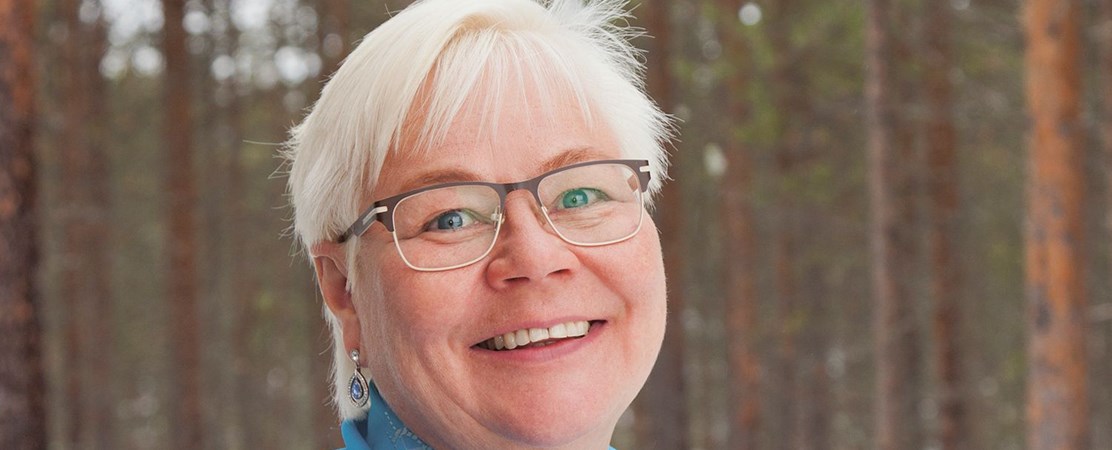Together We Stand Stronger: Interview with Liisa Holmberg

By Marie Søndergaard, Former Intern, UArctic International Secretariat
Far in the North – 350 km north of Rovaniemi, to be exact – is where Inari is located. Yet, this is the place where you will find both the Sámi Education Institute and its rector Liisa Holmberg, who is also the Chair of the Council of UArctic. Between travels and a busy schedule, she luckily had time to meet to talk about her experiences on the collaboration between smaller northern and indigenous institutions.
In 2017, Finns celebrate the 100-year anniversary of their independence. On February 6, 2017 the Sámi also celebrated 100 years of Sámi collaboration. A huge milestone, some would say, and Liisa Holmberg agrees. When I asked her what this milestone means, she could not express it in words. “Come, come – I will show you,” she said and took me to see a wall that the students had decorated with pictures of Elsa Laula. One hundred years ago Elsa Laula actively promoted Sámi matters and convinced women to attend the first Sámi congress in Trondheim, Norway, with the result of forty women attending out of the 150 participants. This is how the collaboration across borders and later between institutions started.
Elsa Laula believed that the most essential was education, language, traditional livelihoods and cooperation across the borders. Now, one hundred years later, this is still essential. After almost losing their identity, language and culture, the Sámi are ready to look forward and plan the next hundred years. “The state almost wiped us away, but we are still here – we are still here, and stronger than ever.”
But how is this collaboration even possible, and why is it important to indigenous and northern institutions?
“UArctic has created a platform making collaboration between smaller and even bigger institutions possible. Even though we are small, the Sámi Education Institute is one of the few concentrated on indigenous lifestyle, clothing and handicrafts. Therefore many want to come and see how we are doing it,” Holmberg explains.
“UArctic has enabled us to make a long-term cooperation agreement with the University of Alaska Fairbanks, making it possible for one of our teachers to travel to Alaska four times a year to teach them reindeer herding and handicrafts. Furthermore, it allows us to send students there for many weeks in a row to learn about their traditions and livelihoods.”
In her opinion, working together is essential in keeping research in the Arctic and also in keeping indigenous cultures alive.
“For us, collaboration is key. Sharing knowledge, learning from each other – that is important. And it is not only about sharing knowledge. It is also about knowing of each other, knowing that there are other indigenous people in the North. It is essential in preserving our culture! Imagine that we are building an Arctic family around the Circumpolar North through UArctic.
That is one way for the indigenous people to stick together, and that is why collaboration across the borders is important. What UArctic does is pure Arctic cooperation; giving and taking within the Arctic region. We collaborate within the Arctic for the Arctic.”
By sharing knowledge between institutions, not only will more people learn about the indigenous lifestyle, but they can also share their programs and learn from each other. One of the biggest achievements for Holmberg, in addition to reindeer herding education, is Sámi language education. She was a part of a group that helped set up a language education program in Russia – something she would never have thought of, had it not been for UArctic.
“We helped indigenous people – the Enets, Nenets, Dolgans and Nganasans – in Russia who almost lost their native languages. We shared our language program with them, and now all three languages are still alive. This is something that would have been impossible without the contacts and support through UArctic. There is no doubt that one of the things we are most proud of is the Sámi language education!”
Holmberg hopes to see the Sámi language as natural in Finland as Swedish is, but there are some challenges. “We are still struggling. They say we are not important.” The lack of funding is also a problem. “It is important to keep sending students to other indigenous communities and stay connected. Within UArctic we have the north2north mobility program, but it is not enough. There are huge exchange programs such as Erasmus in Europe – we need that as well.”
With the support of the network, it is now possible to build ties around the North Pole. Without UArctic as a platform for collaboration, it would have been hard for indigenous students to meet each other, share their knowledge, and remind each other to be proud of being indigenous. Holmberg’s mission is that in the future national states will recognize the indigenous people as a resource instead of a problem.
“When we are together, we are much stronger.”
